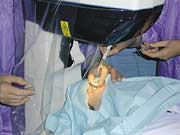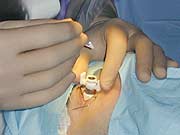Surgeon: New suction trephine improves LASEK
The device prevents the toxic effects of alcohol leakage on the corneal periphery and creates regular, reproducible flaps, surgeon says.
|
|
ROME – A new suction trephine for laser epithelial keratomileusis makes the procedure safer by eliminating the risk of peripheral toxicity due to alcohol leakage, according to its designer.
“A further advantage of the trephine is that it makes regular and reproducible epithelial flaps, which are easily lifted and repositioned on the stroma,” said Joseph Colin, MD, who described the device here at the most recent winter meeting of the European Society of Cataract and Refractive Surgeons. This instrument will be manufactured by Katena Products.
LASEK, he said, first introduced in 1999 by Massimo Camellin, MD, consists of inducing detachment of the corneal epithelium through alcohol solution and replacing it after laser photoablation. The epithelial flap protects the bare surface of the stroma, preventing cell proliferation and therefore haze. Acting as a soft contact lens, the flap should also reduce postoperative pain and promote a faster visual recovery.
“Although some contrasting results have been published, most studies agree that LASEK improves on photorefractive keratectomy. Compared to LASIK, it is preferable when treating thinner corneas, and it avoids flap-related complications and unpredictable induced aberrations,” said Dr. Colin.
Alcohol toxicity
Since it was first described, different instruments have been developed for LASEK. In the most commonly used procedure, the epithelium is stained with a corneal marker and cut with a special trephine. Then an alcohol solution is applied to the cornea for a time varying between 20 seconds and 2 minutes to loosen the epithelial layer.
“The time varies mainly according to age; the younger the patient, the more difficult it is to remove the epithelium. However, the toxic effects of alcohol on the epithelial, stromal and limbal cells should be considered. It seems that to remain within safety limits, the alcohol should be removed after about 30 seconds, because after 60 seconds cellular necrosis occurs,” Dr. Colin said.
In his experience, he said, when using standard LASEK instruments, it is difficult to prevent alcohol leakage outside the margins of the corneal marker. When the patient blinks, the surgeon might slightly lose hold of the instrument, and some alcohol might spread on the conjunctiva, with potentially toxic effects.
No risk of leakage
To prevent alcohol leakage, Prof. Colin designed a new trephine that is fixated to the eye with suction. The instrument has a precalibrated blade length to obtain reproducible 70-µm superficial keratectomies. A safety stop allows the trephine to turn three-fourths of the circle.
“After 20 to 30 seconds we can easily remove the alcohol without any risk of leakage, because the solution is confined inside a closed cylinder,” he said. “The alcohol effect is safely limited into the inner part of the trephine, eliminating the risk of corneal peripheral toxicity.”
The calibrated blade also prevents the cut from penetrating too deeply into the cornea.
“In none of my patients have I had problems lifting the flaps. I felt very comfortable and relaxed because there was no risk of going wrong with the cut,” he said.
Prof. Colin concluded his speech by remarking that refractive surgery is rapidly moving toward the concept of customized wavefront-guided ablation. In this new scenario, the old debate on PRK vs. LASIK has been revisited from a different point of view.
“LASIK remains a viable option for the many advantages that it offers, but microkeratomes need to be improved to avoid alteration of the biomechanical properties of the cornea that induce high- and low-order aberrations,” he said. “On the other hand, PRK has been rehabilitated, because it causes significantly fewer aberrometric changes. LASEK, which improves some of the weaker points of PRK, thus has potential advantages that are worth exploring.”
For Your Information:
- Joseph Colin, MD, can be reached at Hôpital Pellegrin, Place Amélie Raba-Lèon, Bordeaux 33076, France; +(33) 5-56-79-56-08; fax: +(33) 5-56-79-59-09; e-mail: joseph.colin@chu-bordeaux.fr.
- Katena Products can be reached at 4 Stewart Court, Denville, NJ 07834; +(1) 973-989-1600; fax:
+(1) 973-989-8175.


